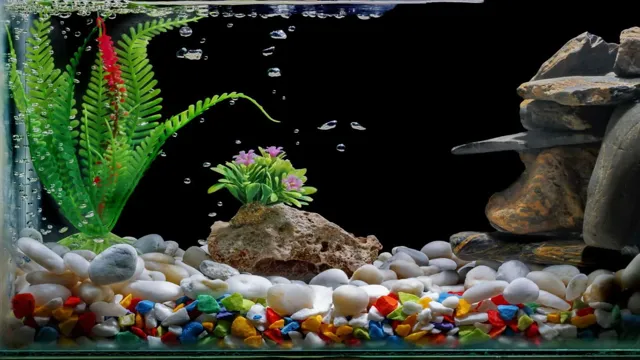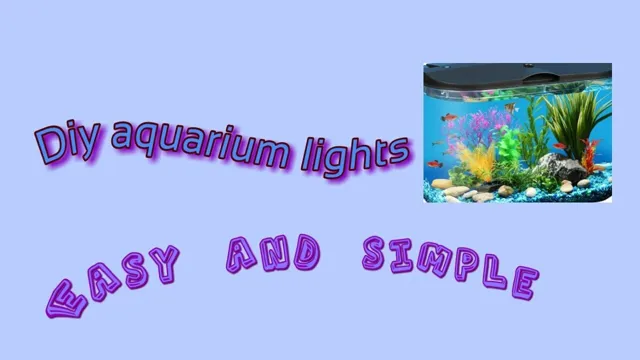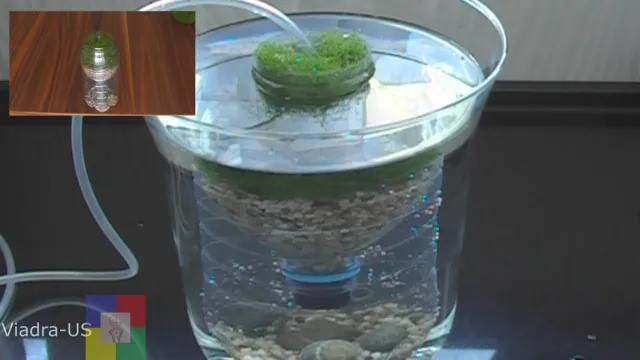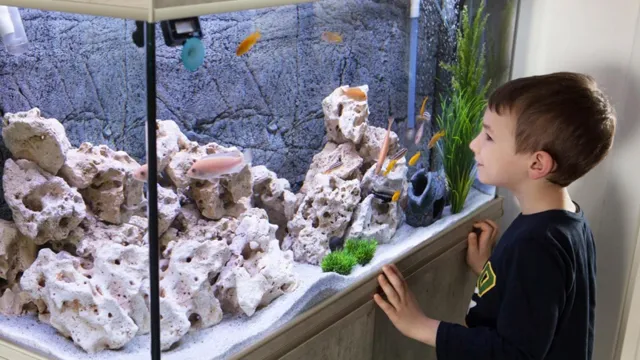Are you looking for a fun and easy way to bring a little piece of the ocean into your home? Creating a mini fish aquarium is a great way to add some life and color to any room. Not only is it a beautiful addition to your decor, but it can also provide a calming and relaxing atmosphere. Whether you are a seasoned aquarium enthusiast or a beginner, creating a mini fish aquarium is a simple and fun project that anyone can enjoy.
With a little setup and some basic knowledge, you can create a thriving ecosystem for your fish and other aquatic creatures. In this blog, we will cover everything you need to know about creating a mini fish aquarium. From choosing the right tank and equipment to selecting the perfect fish and plants, we will guide you through every step of the process.
So, grab your snorkel gear and get ready to dive into the world of mini fish aquariums. Whether you’re looking to add some life to your office or create a stunning centerpiece for your living room, a mini fish aquarium is the perfect way to bring the ocean into your home. Let’s get started!
Materials Needed
To make a mini fish aquarium, you’ll need a few materials to get started. First, you’ll need an aquarium tank that is suitable for the size of fish you plan to keep. Choosing the right tank size is essential because it will ensure that there is enough space for your fish to swim around comfortably.
Next, you’ll need a filter and heater to maintain the water quality and temperature. The filter is responsible for cleaning the water by removing fish waste and debris. The heater will keep the water temperature at a consistent level, which is essential for the health of your fish.
Additionally, you’ll need a substrate, such as gravel or sand, to line the bottom of the aquarium. This will provide a natural environment for your fish and promote healthy bacteria growth. Finally, you’ll need decorations, plants, and possibly a light source to create a beautiful and healthy environment for your fish to thrive.
With these materials, you can create a mini fish aquarium that not only looks fantastic but also provides a safe and healthy environment for your fish to live in.
Fish Tank
If you’re considering setting up a fish tank in your home, there are a few essential materials that you’ll need. Of course, the first thing you’ll need is a tank. The size of the tank you choose will depend on the types of fish you plan to keep.
Once you’ve got your tank, you’ll need substrate to line the bottom. Gravel is popular for this purpose, but there are other options available. You’ll also need a filter to keep your tank clean and water circulation optimal.
Lighting is essential, both for the health of your plants and for showcasing the beauty of your fish. Finally, you’ll need some decor for your fish to swim around and hide in. Some examples include rocks, driftwood, and artificial plants.
With these materials, you’ll be well on your way to creating a vibrant and thriving fish tank in your home.

Gravel or Substrate
When it comes to setting up your aquarium, one important decision to make is whether to use gravel or substrate. Both have their pros and cons, so the choice ultimately depends on what kind of fish and plants you have and what kind of aesthetics you’re going for. If you’re opting for gravel, you’ll need to choose a size that’s appropriate for your tank and your fish.
Small gravel can easily get stuck in a fish’s gills, while large gravel can be difficult for fish to sift through in search of food. Additionally, you’ll need to make sure the gravel is thoroughly cleaned before adding it to your tank to avoid any harmful toxins or bacteria. If you decide on substrate, you’ll have a variety of options to choose from, including sand, soil, and specialized aquarium substrates.
Make sure to research which substrate is best suited for your plants and fish, and consider issues like pH balance and nutrient levels. Ultimately, whichever material you choose, make sure to keep up with regular maintenance to keep your aquarium clean and healthy.
Plants and Decorations
When it comes to creating a beautiful oasis in your home or office space, plants and decorations are essential. To ensure your plants thrive and your decorations look their best, there are a few materials you’ll need. First, you’ll need a variety of plants that suit your space and lighting.
Some popular low-maintenance options include snake plants, pothos, and succulents. Additionally, you’ll need a range of decorative pots or planters, which can be found in a variety of materials such as ceramic, metal, or woven fabric. Other decorative elements to consider include stones, shells, and driftwood, which can add a natural and calming touch to your space.
Lastly, don’t forget about the practical materials like soil, fertilizer, and gardening tools. These will help keep your plants healthy and thriving for years to come. With these materials, you’ll be well on your way to creating a beautiful and peaceful environment that both you and your plants will love.
Water Filter
If you’re looking to create a DIY water filter, there are a few materials you’ll need to get started. First, you’ll need a container to hold the water that you’ll be filtering. This could be a large plastic bucket or even a 5-gallon water jug.
Next, you’ll need a filtration system. There are a variety of filtration systems to choose from, including activated carbon filters, ceramic filters, and reverse osmosis systems. You’ll also need a way to connect the filtration system to the container, such as tubing or a spigot. (See Also: How to Lower Phosphate Levels in Reef Aquarium: A Comprehensive Guide)
Additionally, you may want to consider adding some accessories to your filter system, such as a pre-filter to remove larger debris before it reaches the main filter. With these materials in hand, you’ll be well on your way to creating your very own DIY water filter and enjoying clean, filtered water whenever you need it.
Air Stone
If you are looking to add a bubbly touch to your aquarium, then an air stone is just what you need! To set up an air stone, you will need a few materials. Firstly, you will require an air pump that will supply air to the stone. A suitable air hose measuring about 6 feet long is also essential to connect the pump and the stone.
An air stone, which comes in various shapes and sizes, is the centerpiece of the setup. You will also need suction cups to attach the air stone to the side of your aquarium. A check valve is also an essential component, protecting the pump from water flowing back in case of power loss.
The valve will also help regulate the flow of air to the stone. Lastly, pliers and a pair of scissors will come in handy in cutting and trimming the air hose to the correct length. With these materials, you can set up an air stone easily and bring a breath of fresh air to your aquatic pets.
Preparing the Aquarium
If you’re looking to make a mini fish aquarium, the first step is to prepare the aquarium properly. Firstly, choose an appropriate aquarium size for the type of fish you want to keep. A 5-gallon tank is a good starting point for miniature fish, but always double-check the specific needs of your selected fish before purchasing the aquarium.
After purchasing the aquarium, give it a good clean with warm water and a mild soap to get rid of any debris or dust. Next, add in your substrate material, such as gravel or sand, to the bottom of the tank. This will provide a base for your live plants, which you can add next.
Be sure to select plants that are suitable for your chosen fish species, and arrange them in an aesthetically pleasing way. Fill the tank with de-chlorinated water and let it sit for a day to ensure that everything is running smoothly. Finally, add in any decorations you want, like rocks, driftwood, or a small cave for your fish to explore.
With this preparation, your mini fish aquarium will be ready for the addition of your fishy inhabitants.
Rinse and Add Gravel
When setting up an aquarium, one of the crucial steps is preparing it with a rinse and gravel. This process helps remove any dust, dirt, or debris that may be present in the tank. Start by rinsing the aquarium thoroughly with clean water.
Next, add a layer of gravel to the bottom of the tank. The amount of gravel you need depends on the size of your tank, but a general rule of thumb is one pound of gravel per gallon of water. Gravel not only adds aesthetic value to your aquarium but also serves a functional purpose.
It provides a surface for beneficial bacteria to grow that help break down waste and keep the water clean. After adding the gravel, give it a final rinse to remove any excess debris, and your tank is ready to move onto the next step! By taking the time to properly prepare your aquarium, you’ll help create a healthy and thriving environment for your aquatic pets to call home.
Install Water Filter and Air Stone
When you’re getting ready to set up your aquarium, it’s important to make sure you have everything you need to keep your fish happy and healthy. One of the most important things you’ll need is a water filter to keep the water clean and clear. There are many different types of filters available, but you’ll want to choose one that is appropriate for the size of your aquarium and the types of fish you plan to keep.
Once you have your filter, it’s time to install it. First, rinse the filter media to remove any dust or debris. Then, install the filter in your aquarium according to the manufacturer’s instructions.
You’ll also need to add an air stone to your aquarium to oxygenate the water. This will help ensure that your fish have plenty of oxygen to breathe, which is essential for their health. By taking the time to properly prepare your aquarium with a water filter and air stone, you’ll be well on your way to creating a healthy and happy environment for your fish to thrive!
Add Water and Water Conditioner
When it comes to preparing an aquarium, adding water and water conditioner is an important step to ensure the health and safety of your aquatic pets. But what exactly is water conditioner and why is it necessary? Water conditioner is a solution that removes harmful substances from tap water, such as chlorine and chloramines, that can harm fish and other aquatic life. Using a quality water conditioner is essential for a healthy aquatic environment as it eliminates harmful chemicals and makes the water safe and suitable for your pets to live in.
Once you have added the correct amount of water to your aquarium, it is essential to add the recommended dosage of water conditioner. Failure to do so can result in sick fish and other aquatic pets or even death. So, make sure to follow the instructions on the bottle and add the right amount of water conditioner before introducing your pets to their new home.
By doing this, you can enjoy a healthy and thriving aquarium for years to come.
Choosing the Right Fish
If you’re thinking of creating a mini fish aquarium, the first thing you need to consider is selecting the right fish. While it may be tempting to choose the most colorful and eye-catching fish, it’s essential to do your research. Some fish species are not suitable for small tanks, while others require a lot of maintenance and specific conditions. (See Also: How to Get Rid of Scuds in Aquarium: Easy and Effective Techniques)
Look for fish that are hardy and can tolerate varying conditions. Common options include bettas, guppies, tetras, and shrimp. Bettas are a great choice for small tanks as they don’t require a lot of space and are relatively easy to care for.
Guppies and tetras also do well in community tanks and come in a variety of colors and patterns. Ultimately, the key to a successful mini fish aquarium is choosing fish that are well-suited for the tank’s size and conditions.
Consider Tank Size and Fish Species
When it comes to stocking your aquarium with fish, it’s vital to consider both tank size and fish species. Choosing the right fish for your tank is crucial not only for their health and well-being but also to maintain the overall ecosystem of your aquarium. A tank that’s too small for the number or type of fish will result in a stressful and overcrowded environment, leading to disease and aggression.
On the other hand, a tank that’s too large for your fish can make it challenging for them to find food or shelter, causing anxiety and vulnerability to predators. Therefore, it’s crucial to select fish species that are compatible regarding size, temperament, and water preferences. Before stocking your aquarium, research the potential fish species thoroughly, and learn about their habits, diet, and temperaments.
Keep in mind that some fish have specific dietary needs, so make sure you can provide them with the appropriate food. By choosing the right fish species that thrive in your tank size, you’ll create a harmonious home for your aquatic pets, ensuring their well-being and happiness.
Research Compatible Fish
When it comes to setting up a new fish tank, choosing the right fish is critical to ensuring their health and happiness. Researching compatibility between different species is key to avoiding conflicts that could cause stress, injury, or even death among tankmates. Consider factors such as size, temperament, and tank needs when selecting your fish.
Larger, more aggressive fish may not mix well with smaller, timid species, and some fish require specific water conditions or tank setups to thrive. So, for example, if you’re setting up a community tank with a variety of fish, research and select species that are known to coexist peacefully. Doing so will help ensure a happy and harmonious aquarium, rather than a tank full of stressed-out or injured fish.
Maintaining the Aquarium
If you’re wondering how to make a mini fish aquarium, maintenance is key to keeping your fish healthy and happy. To maintain your aquarium, regular water changes are crucial to ensure that the water quality stays optimal. You should also clean the gravel and remove any leftover food or debris to prevent the buildup of harmful bacteria.
Additionally, make sure to regularly replace any filters to ensure they are working efficiently. Monitoring the temperature and pH levels is also important, as fish require a specific environment to thrive. Depending on your fish species, you may also need to add specific additives or nutrients to ensure their health.
With proper maintenance, your mini fish aquarium can be a beautiful and enjoyable addition to your home or office.
Weekly Water Changes
Weekly water changes are an essential part of maintaining a healthy and thriving aquarium. Neglecting to change the water regularly can result in a buildup of waste and harmful toxins, leading to poor water quality and sick or stressed fish. Different types of fish require different changes in volume and frequency; it is important to research the recommended water change schedules for your specific species.
Generally, a weekly water change of 10-25% of the total tank volume is recommended. Schedule your water change for the same day each week to establish a consistent routine. Remember to treat the new water with a water conditioner to remove chlorine and chloramines before adding it to the tank.
By doing weekly water changes, you can ensure a healthy and happy environment for your aquatic pets, promoting their overall well-being and longevity.
Monitor Water Temperature and PH
Maintaining an aquarium can be a rewarding experience, but it requires regular upkeep to keep the ecosystem healthy and thriving. One important aspect of aquarium maintenance is monitoring the water temperature and pH levels. Temperature affects the metabolism of fish, and a stable temperature between 76-80 degrees Fahrenheit is generally recommended for most freshwater fish.
Fluctuations in pH can also cause stress to fish and other aquatic life, which can lead to disease and even death. The ideal pH range for most freshwater aquariums is between 5-
Testing kits are available at pet stores to help monitor water parameters and adjust them as needed. Water changes should also be performed regularly to continue to keep the conditions in the aquarium optimal.
Overall, maintaining the proper water temperature and pH levels is essential to the health and well-being of fish and other aquatic life, making it a crucial part of aquarium maintenance.
Check and Clean the Filter Regularly
Maintaining an aquarium can be a rewarding experience, but it also comes with responsibilities. One essential aspect of aquarium maintenance is checking and cleaning the filter regularly. The filter is responsible for removing fish waste, uneaten food, and other debris from the water. (See Also: How to Make Your Own Aquarium Filter Cartridge in Simple Steps)
Failure to maintain the filter can lead to poor water quality, which can harm your fish’s health. Therefore, it’s crucial to check the filter regularly to ensure it’s running correctly. You can do this by inspecting the filter media for any signs of clogging and checking the water flow.
If the filter is dirty or clogged, it’s time to clean it. The cleaning process may vary depending on the filter type. However, the general process involves removing the filter media and rinsing it with water or replacing them entirely.
Remember to follow the manufacturer’s instructions and to avoid using soaps or detergents that can harm the fish. By regularly checking and cleaning the filter, you’ll ensure a healthy and thriving aquatic environment for your fish to live in.
Feed Fish Sparingly and Clean Up Excess Food
Maintaining your aquarium is essential to keeping your fish healthy and happy. One important aspect of aquarium maintenance is feeding your fish properly. It’s crucial to feed them sparingly and only enough for them to consume within a few minutes.
Overfeeding can lead to excess food sinking to the bottom of the tank, which can lead to water quality issues. When you do feed your fish, make sure to remove any uneaten food promptly. It’s also a good idea to test the water frequently to make sure the water quality is ideal.
Taking these steps will help keep your fish healthy and your aquarium looking its best. Remember, a healthy aquarium is a happy aquarium!
Conclusion
In conclusion, making a mini fish aquarium is surprisingly easy and rewarding. With just a few simple steps, you can create a peaceful underwater oasis right in your own home. And let’s be real, who wouldn’t want to have a front row seat to the daily drama and antics of their pet fish? So go ahead, give it a try! Your finned friends will thank you, and your guests will be amazed at your impressive DIY skills.
Plus, you’ll have the perfect excuse to use that fish pun you’ve been dying to drop: “I’m not squidding when I say this mini aquarium is the coolest thing I’ve ever made!”
FAQs
What materials do I need to make a mini fish aquarium?
You’ll need a small glass tank, a filter, gravel, plants, and small fish.
How many fish can I keep in a mini aquarium?
It’s recommended to keep only one or two small fish in a mini aquarium, depending on the size of the tank. Overcrowding can lead to health issues for the fish.
Do I need a heater for my mini fish aquarium?
It depends on the type of fish you plan to keep. Some fish require a specific temperature range, in which case a heater would be necessary.
How often do I need to clean my mini fish aquarium?
You should do a partial water change and clean the tank once a week, removing any debris and algae buildup.
Do I need special lighting for my mini fish aquarium?
Some plants and fish may require specific lighting, but a basic LED light can suffice for most mini aquarium setups.
Can I keep freshwater or saltwater fish in a mini aquarium?
You can keep either freshwater or saltwater fish in a mini aquarium, but saltwater setups can be more challenging and require more maintenance.
How do I cycle my mini fish aquarium before adding fish?
You should let the tank run for several weeks with the filter and plants, monitoring water levels and adding ammonia to establish the necessary bacteria for a healthy environment before adding fish.







